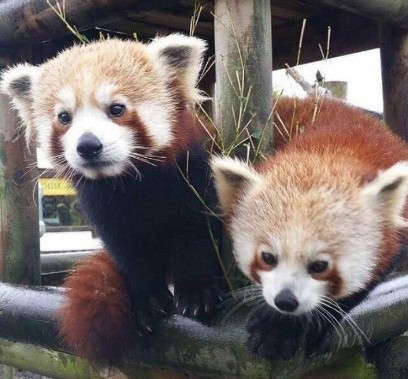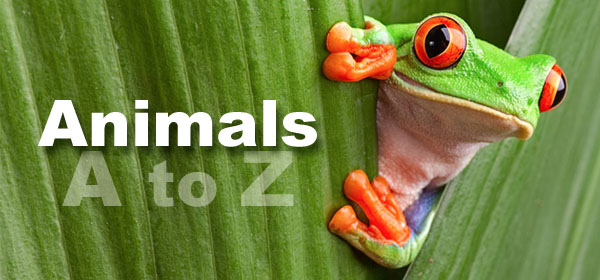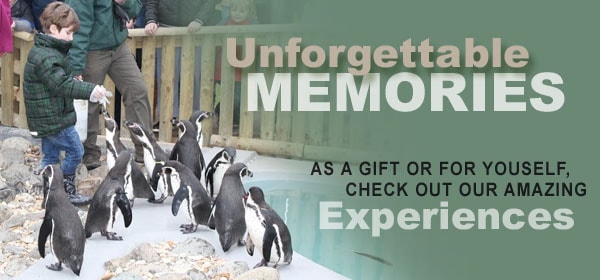For my blog this week, I will be talking about all things red panda. “Why?” you ask. Because on the 20th September we will be celebrating International Red Panda Day. This day falls on the third Saturday in September every year. Also, who doesn’t love a red panda? I’m sure you’ll all agree that they’re one of the most beautiful species in the animal kingdom. I’ve worked with red pandas for over 10 years now and I have never come across an ugly one. In this blog, I thought I’d introduce you to the individuals that we are very lucky to house at Wingham, along with some information on the species, why they’re so important and need our help.
We are currently home to two red pandas; Mai-Xlang and Kai. Mai is 12 years old and was born at Colchester Zoo but has been housed at Wingham Wildlife Park since she was 9 months old. She’s the much smaller one out of the two here and has a much longer and thinner tail. She’s definitely the boss out of the two of them and you can normally find her snoozing in her favourite area, which is at the bottom of the big tree. Mai is a bit of a princess. Loves to groom and make herself look pretty. I always say it’s the Essex in her. We know they love to look glamorous. She’s also very particular and only likes a Pink Lady apple specifically out of all of the apples.

We then have Kai who is 4 years old and was born at Blackpool Zoo, coming to us in in May 2022. He’s the much bigger out of the two and has a much fluffier tail like Basil Brush or a feather duster. He also has a grumpy teddy bear look about him and you’ll normally find him munching away on the bamboo or fast asleep in the middle of the tree. He’s a typical teenage boy. He loves his food and he loves to sleep. Due to his age, he’s also very inquisitive and loves to investigate. He’s a very confident and playful panda when he’s not being lazy!

To the serious part. What is a red panda? They’re a small mammal native to the Himalayas ranging from Nepal to China including places such as Bhutan, Burma, India and Tibet. They have been seen at elevations of up to 4800m above sea level. They have adapted to living in these harsh environments quite well. For example, they have a very thick double coat. This provides insulation against the cold. Keeping them warm and agile in those snowy habitats. As well as having semi retractable claws to help them climb and reversible ankle joints allowing them to rotate their wrists up to 180 degrees to descend down trees headfirst. Unlike most species like your dogs and cats at home, you cannot see a red panda’s ‘toe beans’. Their paws are covered in fur like little snow boots to help them with grip.
A lot of people think red pandas and giant pandas are related. I did until I became a zookeeper. You would just naturally group them together due to the name. However, one of the reasons they share the same name is due to their love for bamboo. There’s a Nepalese phrase ‘nigalya ponya’ which simply means ‘bamboo-eater’ and this could be where the word ‘panda’ comes from. But both species also share anatomical features. Red pandas are the OGs. They’re the original panda named in 1825, nearly 50 years before the giant panda was recorded. Red pandas are actually part of their own little family called ‘Ailuridae’ and giant pandas are part of the bear family. In the past, red pandas were believed to be part of the ‘Procyonidae’ family which includes raccoons. Whereas now, they’re thought to be closely related to mustelids which are animals like otters, skunks, badgers and weasels.
Red pandas are classed as omnivores which always surprises people. They will eat small mammals, birds, insects, eggs, flowers, leaves, you name it. Ours are extremely fussy and don’t eat half of these things, so we feed them something called Panda Cake. It’s not the coffee and walnut cake or the victoria sponge that you’re thinking of. Panda Cake is a special powder designed just for red pandas. It contains all their vitamins and minerals and is very high in fibre. We also add an egg into it every other day to make sure they’re getting plenty of protein. They don’t know we do this, so please don’t tell them. Us keepers have to do what we can when it comes to fussy animals. We then add water to the mixture which is where the term ‘cake’ comes from, because it looks just like that. However, their main diet is bamboo which makes up over 95%. Bamboo is extremely important for their nutrition. They need to eat 20-30% of their body weight in bamboo which equates to thousands of leaves a day. We are very lucky at Wingham and grow bamboo all around the park for them so that we have a constant fresh supply. We don’t grow it directly in their enclosure because even though it’s a fast growing plant, it’s not going to have much chance to grow if our two have anything to do with it. We also want to monitor what they’re eating. Making sure they aren’t on too little or too much food.
We train our red pandas three times a week for health and medical purposes. On Mondays, we do scale training. This is where we get our individuals to walk onto scales to make sure that they’re a nice healthy weight. To give you an idea, our last recorded weights were Mai at 4.12kg and Kai at 5.57kg. An average weight typically tends to be anything from 3kg to 7kg. On Tuesdays, we do something called T-bar training. This is where we have a wooden bar in the shape of the letter T. This allows the pandas to stand up on their hind legs so that we can have a good look at the bodies, particularly their stomachs to make sure there are no lumps, bumps and bruises. Lastly, on a Wednesday, we do crate training and this is to minimize stress. If we ever need to move our pandas to another zoo or take them to the vets, they’re then ready to go and used to transportation. With any of our training sessions, the animals are free to walk away at any time or not come over at all if they don’t want to. However, most of our species love training sessions and really thrive from them due to how enriching they can be and of course because of the tasty snacks that they get. Mai and Kai’s favourites are grapes for example. They get very excited like we do when our favourite chocolate bar is waiting for us when we get home.
Red pandas are classed as endangered on the IUCN red list with less than 2500 individuals remaining in the wild. Unfortunately, the population has declined by 50% in the last 20 years. This is due to habitat loss, poaching of their fur, Chinese medicine and the pet trade. Here at Wingham, we are involved in the EEP for red pandas, which stands for European Ex-Situ programme. In modern terms, the best way to describe this is a dating site for pandas. There’s somebody called an EEP co-ordinator and they’re in charge of the red pandas in zoos across Europe. They play a vital role in the successful management of captive breeding, ensuring the long term survival of endangered species. They make recommendations for breeding and decide where each panda is best placed. Red pandas are a solitary species in the wild but tolerate each other in captivity extremely well. Due to this programme and the efforts of dedicated zookeepers, there are successful births across Europe yearly.
After a 4.5 month gestation, red pandas usually give birth to a single cub or twins but up to 4 has been recorded. They only weigh around 150g when they’re born with their eyes closed. Their eyes start to open at around 2 weeks and they normally start venturing out of the nest at about 3 months. After 9-12 months, the cubs would then go off and defend for themselves and fully reach maturity at about 18 months. They would normally nest in the middle of the tree due to predators at the top such as birds of prey and snow leopards down below. We have been very fortunate to have had cubs born at the park in the past. Kush and Hugo were born on 19th June 2015. The boys stayed with us for about 10 months and then moved to Gaia Zoo in The Netherlands as part of the breeding programme.

Mai was a fantastic mum and we really hope to be able to contribute to the EEP again soon. Let’s face it, everybody loves a baby animal. Especially one from one of the most beautiful species on the planet.
If you’d ever like to come and do one of our red panda experiences. We offer them every day at 10.30am. They get pretty booked up, which means they must be good. Come and learn more about our wonderful red pandas and the other species that are housed here at Wingham. By you visiting the park, your money goes towards helping our charity, Wingham Wildlife Park Animal Welfare, which supports animal welfare and conservation by: relieving the suffering of animals, conserving Earth’s natural resources, preserving and protecting living animals and their habitats and educating the public through programmes raising awareness and respect for nature.
Thank you for taking the time to read my blog and I hope you’ve all had a wonderful Summer. I know it’s getting colder but just remember it’s now becoming the perfect time to see our red pandas out and about.


